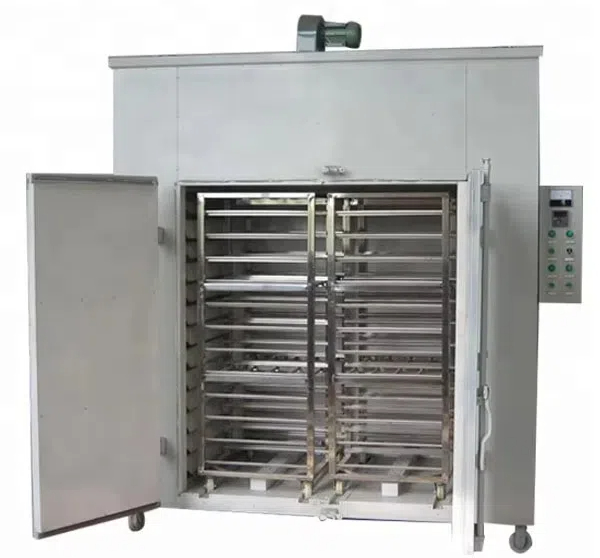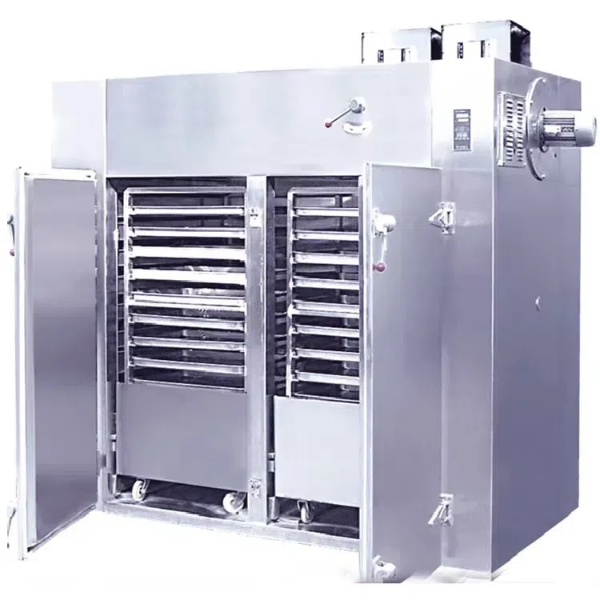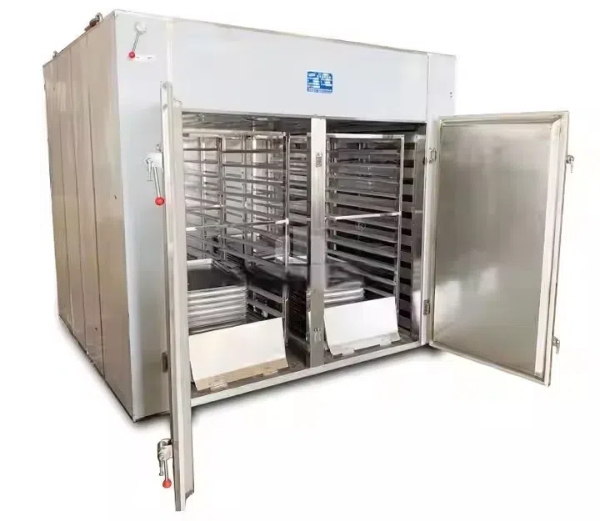
Content Menu
● Introduction
>> The Evolution of Food Drying Technologies
>> What is Hang Type Drying Technology?
● Key Benefits of Hang Type Drying Technology
>> 1. Enhanced Air Circulation
>> 2. Minimal Surface Contact
>> 3. Preservation of Product Quality
>> 4. Energy Efficiency
>> 5. Versatility and Adaptability
● Applications of Hang Type Drying in the Food Industry
>> Herbs and Spices
>> Noodles and Pasta
>> Sausages and Cured Meats
>> Specialty Fruits & Vegetables
>> Nuts & Seeds
● Considerations for Implementing Hang Type Drying Technology
>> 1. Space Requirements
>> 2. Labor Costs
>> 3. Environmental Control
>> 4. Product Handling
● OEM Services for Hang Type Food Drying Machines
>> 1. Customization
>> 2. Integration
>> 3. Automation
>> 4. Control Systems
>> 5. Energy Efficiency
>> 6. Compliance
● Conclusion
● FAQ
>> 1. What types of food are best suited for hang type drying?
>> 2. How does hang type drying compare to tray drying?
>> 3. What are main advantages using this method herbs spices?
>> 4. Can automation utilized within these systems?
>> 5. What factors should be considered when choosing a system?
● Citations:
Introduction
Food drying is an age-old preservation technique that has been utilized by civilizations across the globe for millennia. By removing moisture from food, drying inhibits the growth of microorganisms and enzymatic activity, thereby extending shelf life and maintaining nutritional value. In modern food processing, various drying technologies are employed, each with its own set of advantages and disadvantages. Among these technologies, hang type drying stands out as a versatile and efficient method for specific applications. This article aims to explore the benefits of hang type drying technology in the context of food processing, particularly for OEM (Original Equipment Manufacturer) service providers catering to international brands, wholesalers, and manufacturers.

The Evolution of Food Drying Technologies
From sun-drying to sophisticated industrial systems, food drying technologies have evolved significantly over time. Traditional methods such as sun-drying and air-drying are still practiced in many parts of the world, particularly for fruits, vegetables, and herbs. However, these methods are highly dependent on weather conditions and can be slow and inconsistent.
Modern drying technologies offer greater control over the drying process, resulting in higher product quality and efficiency. Some of the most common methods include:
- Tray Drying: Food items are spread on trays and placed in a drying chamber with controlled temperature and airflow.
- Tunnel Drying: Food products move through a tunnel on a conveyor belt, exposed to heated air.
- Spray Drying: Liquid foods are atomized into a hot air stream, resulting in a powder.
- Freeze Drying: Food is frozen and then subjected to a vacuum to remove ice crystals through sublimation.
- Hang Type Drying: Food items are suspended from racks or lines within a controlled environment to facilitate drying.
What is Hang Type Drying Technology?
Hang type drying, as the name suggests, involves suspending food items from racks, lines, or specialized hangers within a drying chamber. This method is particularly suitable for products that benefit from even air circulation and minimal contact with surfaces. It is commonly used for drying:
- Herbs and Spices: Bunches of herbs or spices are hung upside down to preserve essential oils and flavors.
- Noodles and Pasta: Long strands of noodles or pasta are hung to prevent clumping and ensure uniform drying.
- Sausages and Meat Products: Sausages and other cured meats are hung to allow for proper air circulation and moisture removal.
- Certain Fruits and Vegetables: Some fruits and vegetables, such as peppers or garlic, can be hung to dry, especially in smaller-scale operations.
Key Benefits of Hang Type Drying Technology
Hang type drying offers several distinct advantages, making it an attractive option for food processors seeking quality, efficiency, and versatility.
1. Enhanced Air Circulation
One of the primary benefits of hang type drying is the enhanced air circulation around the food items. By suspending products, air can flow freely on all sides, ensuring even and consistent drying. This is particularly important for products that are prone to mold growth or spoilage if moisture is not removed uniformly.
- Reduced Drying Time: Improved air circulation accelerates the drying process, reducing the time required to achieve the desired moisture content.
- Uniform Moisture Removal: Consistent airflow prevents localized over-drying or under-drying, resulting in a more uniform final product.
2. Minimal Surface Contact
Hanging food items minimizes contact with surfaces, which can be a significant advantage for delicate or sticky products. This reduces the risk of:
- Sticking and Clumping: Products like noodles or herbs are less likely to stick together, maintaining their individual shape and quality.
- Surface Damage: Delicate items are protected from abrasion or pressure that can occur when they are placed on trays or conveyors.
- Contamination: Reduced surface contact minimizes the potential for contamination from drying equipment.
3. Preservation of Product Quality
Hang type drying can contribute to the preservation of product quality in several ways:
- Retention of Volatile Compounds: For herbs and spices, hanging allows for gentle drying that minimizes the loss of essential oils and aromatic compounds.
- Color and Texture: The even drying process helps maintain the natural color and texture of food products.
- Prevention of Case Hardening: Uniform moisture removal reduces the risk of case hardening, where the outer layer of the food dries too quickly, trapping moisture inside.
4. Energy Efficiency
While not always the most energy-efficient method, hang type drying can be optimized for energy savings. By controlling temperature, humidity, and airflow, processors can minimize energy consumption while maintaining product quality.
- Natural Convection: In some setups, natural convection can be used to supplement forced air circulation, reducing the need for energy-intensive fans.
- Precise Control: Modern control systems allow for precise adjustment of drying parameters, optimizing energy use based on the specific product and environmental conditions.
5. Versatility and Adaptability
Hang type drying systems can be adapted to a wide range of food products and processing environments. This versatility makes them a valuable asset for OEM service providers who need to accommodate diverse client needs.
- Customizable Racks and Hangers: Racks and hangers can be designed to accommodate different product sizes, shapes, and weights.
- Scalability: Hang type drying systems can be scaled up or down to meet varying production volumes.
- Integration with Other Technologies: Hang type drying can be integrated with other drying methods, such as pre-drying or post-drying treatments, to further enhance product quality and efficiency.

Applications of Hang Type Drying in the Food Industry
Hang type drying technology finds applications across various segments of the food industry. Some notable examples include:
Herbs and Spices
Hang type drying is particularly well-suited for herbs and spices where preserving volatile oils is crucial. Bunches of herbs are hung upside down in a controlled environment allowing gentle yet effective moisture removal.
- Example: A spice manufacturer uses a hang type system to dry basil while ensuring maximum flavor retention through optimal airflow management.
Noodles and Pasta
For long strands like noodles or pasta hanging prevents clumping while ensuring uniformity during the drying process. This method is widely used in producing traditional Asian noodles as well as artisanal pasta varieties.
- Example: A pasta producer employs a hang-type system specifically designed for spaghetti which maintains its shape without any breakage during processing.
Sausages and Cured Meats
Sausages benefit immensely from even air circulation provided by hang-type systems which allows proper moisture removal essential for curing these products effectively.
- Example: A sausage maker uses this technology extensively when producing salami ensuring consistent curing throughout each batch leading to enhanced flavor development.
Specialty Fruits & Vegetables
Certain fruits such as chili peppers or garlic cloves lend themselves well to being dried using this method particularly beneficial in smaller-scale operations focusing on specialty products.
- Example: A small farm utilizes hanging racks designed specifically for their unique variety of chili peppers creating flavorful dried options sold at local markets.
Nuts & Seeds
Another application often overlooked is using hang-type systems for nuts & seeds which require careful handling during processing due to their delicate nature; this approach helps maintain integrity while achieving optimal dryness levels without compromising quality.
Considerations for Implementing Hang Type Drying Technology
While hang type drying offers numerous benefits there are several factors one must consider when implementing this technology:
1. Space Requirements
Hang-type systems typically require more vertical space than other methods; processors need sufficient ceiling height accommodating both racks & products being processed effectively without hindrance.
2. Labor Costs
Loading/unloading hanging racks can prove labor-intensive especially large-scale operations hence automation becomes crucial reducing overall labor costs significantly while improving productivity rates across all stages involved within production cycles.
3. Environmental Control
Maintaining precise control over temperature humidity & airflow remains paramount ensuring successful outcomes during each cycle; investing reliable environmental control systems guarantees consistent product quality throughout processes undertaken daily by manufacturers utilizing such technologies efficiently.
4. Product Handling
Delicate/frangible items necessitate special handling procedures preventing damage occurring during loading/unloading phases; training staff accordingly implementing appropriate protocols ensures safety standards upheld throughout entire operation lifecycle leading optimal results achieved consistently across board!
OEM Services for Hang Type Food Drying Machines
As an OEM service provider understanding nuances surrounding hang-type technology becomes essential meeting diverse needs international brands wholesalers manufacturers alike! Here's what you should focus on offering:
1. Customization
Offer customizable solutions tailored specifically around client requirements accommodating unique specifications regarding product dimensions weight etc., ensuring satisfaction achieved every time!
2. Integration
Provide seamless integration capabilities combining various types equipment enhancing overall functionality across multiple stages involved within production processes maximizing efficiency levels attained!
3. Automation
Incorporate advanced automation features streamlining operations reducing manual labor requirements thus increasing output rates significantly whilst maintaining high standards expected by clients globally!
4. Control Systems
Implement cutting-edge control systems allowing precise monitoring adjustments necessary optimizing performance levels achieved throughout entire lifecycle ensuring maximum productivity attained consistently!
5. Energy Efficiency
Design energy-efficient solutions minimizing consumption costs associated with running machinery effectively while still delivering top-quality results expected by consumers worldwide!
6. Compliance
Ensure all equipment complies with international safety hygiene standards guaranteeing peace-of-mind clients operating within regulated environments avoiding potential liabilities arising from non-compliance issues encountered during inspections audits etc., safeguarding reputation built over years!
Conclusion
Hang-type technology presents unique advantages benefiting processors seeking enhance product quality improve efficiency preserve natural characteristics foods processed therein! Its ability provide enhanced air circulation minimize surface contact along with preserving overall integrity final output makes it highly attractive option wide array applications ranging herbs spices noodles cured meats etc.! As an OEM service provider understanding intricacies surrounding this technology critical meeting diverse needs international clientele delivering customized solutions driving success forward! By offering tailored integrated automated energy-efficient systems you can help clients optimize operations delivering high-quality products global market effectively!

FAQ
1. What types of food are best suited for hang type drying?
Hang-type systems work best foods requiring even airflow minimal surface contact such as herbs spices noodles pasta sausages certain fruits vegetables!
2. How does hang type drying compare to tray drying?
Compared tray-drying methods provide better airflow minimizing surface contact resulting superior quality outputs achieved consistently across all batches produced!
3. What are main advantages using this method herbs spices?
Preservation volatile oils aromatic compounds crucial retaining flavors enhancing overall taste experience consumers enjoy when utilizing these ingredients culinary creations made possible through effective processing techniques employed here!
4. Can automation utilized within these systems?
Absolutely! Automation features streamline operations reduce labor costs improve productivity rates significantly enhancing efficiency levels attained throughout entire lifecycle processes undertaken daily by manufacturers utilizing such technologies effectively!
5. What factors should be considered when choosing a system?
Key considerations include space requirements labor costs environmental control product handling energy efficiency compliance regulations governing industry standards ensuring safety hygiene upheld throughout entire operation lifecycle leading optimal results achieved consistently across board!
Citations:
[1] https://www.bchydro.com/news/conservation/2019/hang-dry-your-clothes.html
[2] https://patents.google.com/patent/CN110207480A/zh
[3] https://metro.com/blog/hang-drying-cannabis-vs-tray-drying-cannabis/
[4] https://patents.google.com/patent/WO2017197612A1/zh
[5] https://www.bchydro.com/powersmart/residential/tips-technologies/hang-dry-laundry.html
[6] https://patents.google.com/patent/CN1405396A/zh
[7] https://www.kingstarwasher.com/news/industry-news/what-are-the-advantages-of-the-drying-technology-used-in-the-25kg-commercial-dryer.html
[8] https://patents.google.com/patent/CN109252340A/zh











